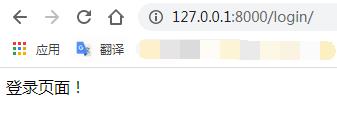第二章--django--URL和视图函数
Posted HonyL
tags:
篇首语:本文由小常识网(cha138.com)小编为大家整理,主要介绍了第二章--django--URL和视图函数相关的知识,希望对你有一定的参考价值。
前言
Django 中的视图的概念是一类具有相同功能和模板的网页的集合。通俗一点来说,就是你平常打开浏览器,看到浏览器窗口展示出来的页面内容,那就是视图。
前面一章通过浏览器访问 http://127.0.0.1:8000 能在页面上展示出Django的内容,通常我们打开浏览器页面,展示的是一个html页面,本篇讲下如何打开html页面。
新建APP
上一篇通过django-admin startproject mysite是创建项目,一个项目下可以有多个应用(app);打开cmd,cd到manage.py所在目录使用如下输入指令创建一个应用:
python manage.py startapp app01
settings 配置文件参数说明
| 变量 | 说明 |
|---|---|
| BASE_DIR | 当前文件绝对路径 |
| SECRET_KEY | 秘钥 |
| DEBUG | 调试模式 |
| ALLOWED_HOSTS | |
| INSTALLED_APPS | 应用程序定义 |
| MIDDLEWARE | 中间件 |
| ROOT_URLCONF | |
| TEMPLATES | 模板配置 |
| WSGI_APPLICATION | |
| DATABASES | 数据库 |
| AUTH_PASSWORD_VALIDATORS | 密码验证 |
| STATIC_URL | 静态文件配置 |
修改配置文件
在写代码前需要先修改相关配置:
-
templates
HTML模板文件目录,一般创建工程时django会自动创建
-
static
静态文件目录,例如:img、gif、CSS、javascript等等
-
settings文件修改部分:
- 添加HTML模板配置路径:
TEMPLATES = [
{
\'BACKEND\': \'django.template.backends.django.DjangoTemplates\',
\'DIRS\':[os.path.join(BASE_DIR, \'templates\')], # 修改部分
\'APP_DIRS\': True,
\'OPTIONS\': {
\'context_processors\': [
\'django.template.context_processors.debug\',
\'django.template.context_processors.request\',
\'django.contrib.auth.context_processors.auth\',
\'django.contrib.messages.context_processors.messages\',
],
},
},
]
- 添加静态文件路径:
STATIC_URL = \'/static/\'
STATICFILES_DIRS = (os.path.join(BASE_DIR, \'static\'),) # 修改部分
3. APP注册
INSTALLED_APPS = [
\'django.contrib.admin\',
\'django.contrib.auth\',
\'django.contrib.contenttypes\',
\'django.contrib.sessions\',
\'django.contrib.messages\',
\'django.contrib.staticfiles\',
\'app01\', # 添加自己的APP
]
视图和 URL绑定
视图函数中 HttpResponse 用法:
HttpResponse : 只支持字符串格式,传入的内容会直接在页面中显示
- 在mysite/app01/views.py里写视图函数:
from django.urls import path
from django.shortcuts import HttpResponse
def login(request):
""" 处理用户请求,并返回内容
:param request: 用户请求相关的信息(对象)
:return: 页面要显示的内容
"""
# HttpResponse 只接收字符串信息
return HttpResponse("登录页面!") # 传入什么内容,页面就显示什么内容。
- 在mysite/urls.py里写URL绑定视图:
from django.urls import path
from app01 import views
urlpatterns = [
# URL 与视图函数进行绑定。
path(\'login/\', views.login), ]
- 启动服务后,打开 URL 页面显示:

视图函数中 render 用法:
render : 主要是给HTML模板进行渲染,将服务端的数据渲染后传入到页面中。
参数:request、\'HTML模板文件名\' 、{需要传递的数据}
ps: 最后一个参数为可选项,为字典格式。
- 在mysite/app01/views.py里写视图函数:
from django.urls import path
from django.shortcuts import HttpResponse
def login(request):
""" 处理用户请求,并返回内容
:param request: 用户请求相关的信息(对象)
:return: 页面要显示的内容
"""
# HttpResponse 只接收字符串信息
return render(request, \'login.html\')
login.html文件在[mysite\\templates\\login.html] 路径下。
render 模块会根据[settings]配置文件,自动的从templates目录下查找对应的HTML模板文件,将读取内容返回页面。
- 在mysite/templates 目录下,创建
login.html文件
<!DOCTYPE html>
<html lang="en">
<head>
<meta charset="UTF-8">
<title></title>
</head>
<body>
<h1>用户登录</h1>
<input type="text" name="name">
</body>
</html>
- 在mysite/urls.py里写URL绑定视图:
from django.urls import path
from app01 import views
urlpatterns = [ # URL 与视图函数进行绑定。
path(\'login/\', views.login), ]
- 启动服务器后,打开 URL 页面显示:

视图函数中 redirect 用法:
redirect : 给页面加个[添加]跳转页面,在[添加]页面往数据库中添加数据后返回指定页面。
- 在mysite/app01/views.py里写视图函数:
from django.shortcuts import render, redirect
def index(request):
if request.method == "POST":
return redirect(\'http://www.baidu.com\') # 配置跳转页面
else:
return render(request, \'index.html\')
- 在mysite/urls.py里写URL绑定视图:
from django.urls import re_path
from app01 import views
urlpatterns = [
re_path(r\'^index/\', views.index), ]
- 在mysite/templates 目录下,创建
index.html文件
<!DOCTYPE html>
<html lang="en">
<head>
<meta charset="UTF-8">
<title>index</title>
</head>
<body>
<form method="post" action="/index/">
<input type="text" name="text">
<input type="submit" name="提交">
</form>
</body>
</html>
- 启动服务器后,打开 URL 页面显示,单击按钮后跳转到百度页面:

案例
代码内容说明:
1. 用户登录页面,账号登录成功时,重定向到百度页面;
2. 登录失败时,返回用户登录页面,并提示登录失败;
# \\mysite\\mysite\\urls.py
from django.urls import path
from app01 import views
urlpatterns = [ # 绑定 URL 与视图函数。
path(\'login/\', views.login), ]
# \\mysite\\app01\\views.py
from django.shortcuts import render, redirect
def login(request):
if request.method == "GET":
return render(request, \'login.html\')
else:
# 用户post提交的数据
u = request.POST.get(\'user\') # 当 key 不存在时返回 None
p = request.POST.get(\'pwd\')
if u == \'root\' and p == \'123\':
# 登录成功 redirect:重定向地址
return redirect(\'http://www.baidu.com\')
else:
# 登录失败 模板渲染msg:特殊提示字符,与HTML中 msg 对应
return render(request, \'login.html\', {\'msg\': \'账号或密码不对!\'})
# mysite\\templates\\login.html
<!DOCTYPE html>
<html lang="en">
<head>
<meta charset="UTF-8">
<title>登录</title>
<!-- 导入CSS文件 -->
<link rel="stylesheet" href="/static/common.css">
</head>
<body>
<h1> 用户登录 </h1> <!-- 字体改为红色 -->
<form method="post" action="/login/">
<!-- method 提交表单 -->
<input type="text" name="user"/>
<input type="pwd" name="pwd"/>
<input type="submit" name="登录"/>
{{ msg }} <!--通过render方法传递数据 特殊提醒字符 提醒登录失败信息 -->
</form>
</body>
</html>
以上是关于第二章--django--URL和视图函数的主要内容,如果未能解决你的问题,请参考以下文章